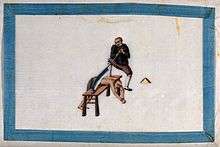Waist chop

Waist chop (腰斬; 腰斩; yāo zhǎn) or waist cutting was a form of execution used in ancient China.[1] As its name implies, it involved the condemned being sliced into two at the waist by an executioner.
History
Waist chop first appeared in the Zhou dynasty. There were three forms of execution used in the Zhou dynasty: chelie (車裂; quartering the prisoner alive), zhan (斬; waist chop), and sha (殺; beheading).[2] Sometimes the chopping was not limited to one slice. Gao Qi, a Ming dynasty poet, was sentenced by the Hongwu Emperor to be sliced into eight parts for his politically satirical writing.[3] An episode not attested in the official histories tells that in 1734, Yu Hongtu (俞鴻圖), the Education Administrator of Henan, was sentenced to waist chop. After being cut in two at the waist, he stayed alive long enough to write the Chinese character cǎn (慘; "terrible/miserable") seven times with his own blood before dying. After hearing this, the Yongzheng Emperor abolished this form of execution.[4]
See also
- Hemicorporectomy, a surgical procedure
References
- ↑ American Association for Chinese Studies (1998). American Journal of Chinese Studies. American Association for Chinese Studies.
- ↑ "揭秘古代酷刑:"腰斩"的历史从产生到消失_资讯_凤凰网". news.ifeng.com. Retrieved 2014-04-24.
- ↑ 祝允明《野记》:“魏守(观)欲复府治,兼疏溶城中河。御史张度劾公,有‘典灭王之基,开败国之河’之语。盖以旧治先为伪周所处,而卧龙街西淤川,即旧所谓锦帆泾故也。上大怒,置公极典。高太史启,以作《新府上梁文》与王彝皆与其难。高被截为八段-{云}-。”
- ↑ 林濤《正說清朝三百年》